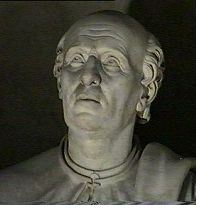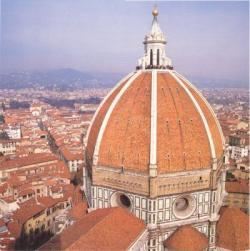 Brunelleschi was the second son of a notary of good standing in Florence. After a successful apprenticeship with a goldsmith and sculptor he applied for registration in the Arte della Seta as a sculptor and was declared a master in 1401.
Brunelleschi was the second son of a notary of good standing in Florence. After a successful apprenticeship with a goldsmith and sculptor he applied for registration in the Arte della Seta as a sculptor and was declared a master in 1401.Italian master architect of the Renaissance, b. 1377 (Florence, Italy), d. 15 April 1446 (Florence).
 Brunelleschi was the second son of a notary of good standing in Florence. After a successful apprenticeship with a goldsmith and sculptor he applied for registration in the Arte della Seta as a sculptor and was declared a master in 1401.
Brunelleschi was the second son of a notary of good standing in Florence. After a successful apprenticeship with a goldsmith and sculptor he applied for registration in the Arte della Seta as a sculptor and was declared a master in 1401.
Florence was a centre of art at the time, home to many talented and famous artists. The young master Brunelleschi competed in 1401 against six other sculptors for the commission to produce the bronze door to the Baptistery of Florence. His design "The Sacrifice of Isaac" impresses through the vivid gestures of the persons, who are shown at the most dramatic moment of the illustrated story, and is considered the high point of Brunelleschi's career as a sculptor. Without doubt he would have produced even better work, if he had continued as a sculptor. But he did not win the competition, abandoned sculpture as an occupation and turned to architecture.
When Brunelleschi rediscovered the geometrical principles of perspective drawing some time around 1410 - 1415, Italy's painters took to his discovery with enthusiasm. Alberti wrote its rules down in 1435.
In 1418 Brunelleschi entered the competition for the construction of the cupola (dome) for the Cathedral, which had been designed during the late Gothic period as a pointed vault. Construction of the Cathedral had begun in 1298, and in 1418 only the cupola remained to be completed. It had to be built on an enormous octagon without exterior buttress support, a problem that had occupied several architects before. Brunelleschi's submission proposed a construction without the traditional wooden frame, using a herringbone structure of stone beams filled with brickwork. Again, Brunelleschi's technique was a re-invention and further development of ancient Roman skills.
Brunelleschi's entry was accepted in 1420, and he became chief architect (capomaestro) for the Dome of Florence, a post he kept until his death. He was now the leading architect in Florence and supervised many projects of religious and military character. His many churches demonstrate his personal development from Gothic roots to contributions to the definition of early Renaissance architecture. Among his major works are
Brunelleschi was probably also active in building works related to the many palaces of Florence; but no documentation exists to prove his involvement. He was also commissioned with the construction and improvement of fortifications in several cities under Florentine control. Among the extraordinary concentration of talent in Florence at the time he was without doubt one of the greatest.
Hyman, I. (1995) Filippo Brunelleschi. Encyclopaedia Britannica 15th ed.
The cupola of the Dome of Florence (Santa Maria del Fiore).

Sketch of the construction principles adopted in the Dome.
